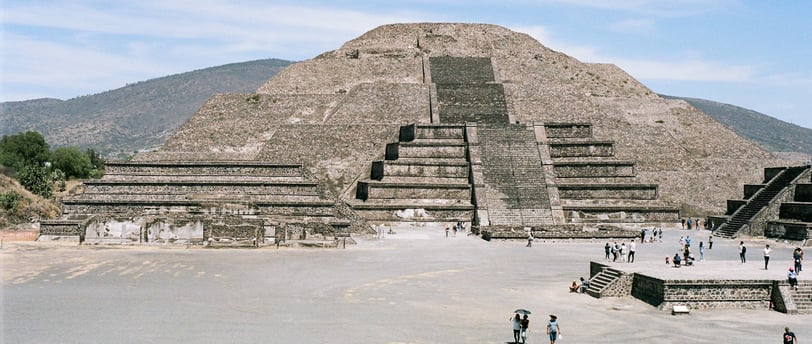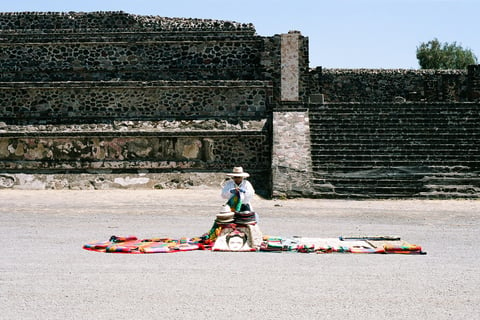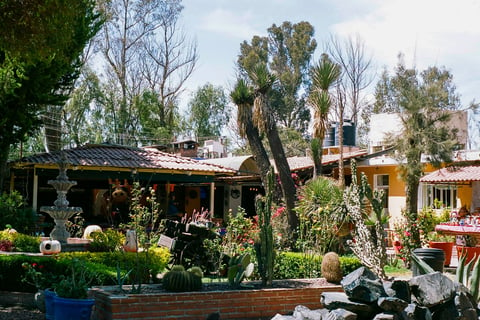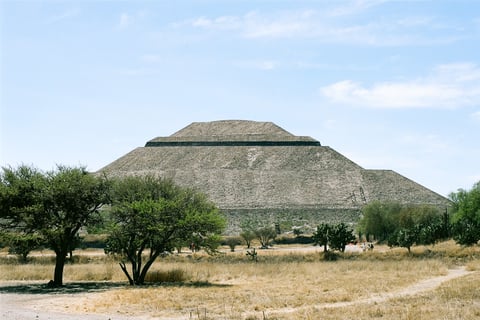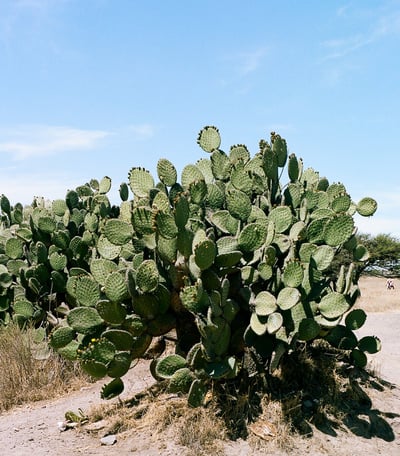Travel Back in Time to San Juan Teotihuacán: A Journey Through Ancient Grandeur
Travel back in time to San Juan Teotihuacán, a city shrouded in mystery and ancient grandeur. This article explores the incredible history of the Teotihuacán civilization, from the construction of the towering Pyramids of the Sun and Moon to the Avenue of the Dead and the Temple of Quetzalcoatl. Through stories of ancient beliefs, artistry, and architecture, discover why this UNESCO World Heritage Site remains a must-visit for travelers seeking both history and awe-inspiring landscapes.
Stephanie Luca
11/16/20248 min read
All Photo Credit to Visuals by Sade
Introduction to Teotihuacán: A City of Mysteries
San Juan Teotihuacán, often simply referred to as Teotihuacán, is one of the most significant archaeological sites in Mexico and a pivotal location in Mesoamerican history. This ancient city flourished between approximately 100 BC and 750 AD, serving as an influential cultural and economic center. The picturesque site, characterized by its grand pyramids and intricate urban layout, reflects the architectural ingenuity and advanced sociopolitical organization of its time.
The true origins of Teotihuacán remain shrouded in mystery. Although it is often associated with various Mesoamerican cultures, its founders and early inhabitants are largely unknown, contributing to its enigmatic nature. The city's name, which translates to "the place where the gods were created," suggests its lofty status in the spiritual dimension of the people who lived in its vicinity. Historical records indicate that at its peak, Teotihuacán was one of the largest cities in the world, with an estimated population of over 100,000 inhabitants. The city thrived for centuries, drawing people from across Mesoamerica.
Teotihuacán’s grandeur is evident in its monumental structures, most notably the Pyramid of the Sun, the Pyramid of the Moon, and the Temple of the Feathered Serpent. Each of these edifices offers a glimpse into the sophisticated astronomical and religious beliefs held by its ancient residents. Moreover, the extensive urban planning and intricate layout of the city, including the Avenue of the Dead, demonstrate a remarkable understanding of urban design that was far ahead of its time.
In recognition of its historical and cultural importance, Teotihuacán was designated a UNESCO World Heritage Site in 1987, ensuring the preservation of its ancient grandeur for future generations. Visitors to this ancient metropolis can expect to delve into its mysteries and uncover the compelling narratives behind its rise and fall, setting the stage for an unforgettable journey through the annals of history.
The Pyramids: Architectural Marvels of the Sun and Moon
The Pyramids of Teotihuacán, specifically the Pyramid of the Sun and the Pyramid of the Moon, stand as monumental testaments to the architectural prowess of the ancient Teotihuacán civilization. Constructed during the height of Teotihuacán's influence, these structures were not merely edifices but held profound religious and social significance. The Pyramid of the Sun, one of the largest pyramids in the world, reaches an awe-inspiring height of approximately 66 meters and covers a base area of around 224,000 square meters. This grand structure is believed to have been built in two phases between the 1st and 2nd centuries CE, showcasing advanced construction techniques that utilized both stone and adobe materials.
Conversely, the Pyramid of the Moon, although slightly smaller, measures about 43 meters in height and is intricately connected to the surrounding landscape. Its construction aligns with the nearby mountains, suggesting that the builders possessed a sophisticated understanding of astronomy and spatial relationships. The significance of these pyramids extends beyond their architectural dimensions; they are seen as central to the religious life of the Teotihuacán society. It is thought that these sites were venues for rituals and ceremonies, enhancing the community's spiritual fabric.
Symbolism plays a crucial role in the pyramids' design. The Pyramid of the Sun is often associated with life, light, and fertility, while the Pyramid of the Moon is linked to water and the cycle of life and death. This duality resonates with the Teotihuacán worldview, emphasizing the interplay between contrasting forces in nature. Today, these pyramids attract countless tourists who seek to immerse themselves in the ancient grandeur and gain insight into the civilization that crafted these architectural marvels, ensuring their continuing significance as a cultural heritage site and a popular travel destination.
The Avenue of the Dead: A Path Through History
The Avenue of the Dead, the central axis of Teotihuacán, is a remarkable thoroughfare that serves as the backbone of this ancient city. Spanning approximately two miles, it connects a series of significant temples and buildings, illustrating the grandeur of Teotihuacán at its zenith. This monumental pathway is more than just a route; it represents the spiritual and physical cohesion of this mysterious civilization.
The architecture found along the Avenue of the Dead is indicative of the advanced engineering and artistic capabilities of its builders. The pathway itself is lined with platforms and palaces that not only served practical purposes but were also deeply embedded in the ritualistic practices of its inhabitants. Rituals performed along the avenue were believed to enhance the connection between the celestial and terrestrial realms, celebrating the gods and sustaining harmony within the city. Thus, the Avenue of the Dead shaped the urban and spiritual life of Teotihuacán, leaving an indelible mark on its cultural landscape. As we traverse this historic route today, one can sense the echoes of the past and the whispers of a civilization that once thrived in this ancient metropolis.
The Temple of Quetzalcoatl: Tales of Deities and Rituals
The Temple of Quetzalcoatl, also known as the Temple of the Feathered Serpent, stands as a testament to the religious fervor and architectural prowess of the ancient Teotihuacán civilization. Constructed around the early centuries A.D., this temple is intricately linked to the feathered serpent deity, Quetzalcoatl, who epitomizes the duality of nature, embodying both earthly and celestial attributes. The worship of Quetzalcoatl intertwined with the community’s agricultural practices, symbolizing the relationship between the heavens and earth, making this deity integral to the spiritual and daily lives of the Teotihuacán people.
The temple's façade is adorned with impressive stone carvings that narrate the rich mythology of this civilization. These elaborate sculptures not only serve religious purposes but also convey the socio-political dynamics of Teotihuacán during its peak. The presence of various serpentine motifs along the temple’s walls reinforces the significant role of Quetzalcoatl in Teotihuacán’s pantheon and highlights his association with fertility, wisdom, and the arts.
Archaeological excavations at the site have revealed an array of artifacts, including offerings left by worshippers to honor Quetzalcoatl. Among these discoveries, pottery, figurines, and tools emphasize the importance of ritual practices that marked various stages of life, from birth to agricultural cycles. These findings elucidate the ceremonial life of Teotihuacán, illustrating how regular offerings and observances were intertwined with their economy and the sustenance of their society.
Moreover, the alignment of the Temple of Quetzalcoatl with astronomical events underscores the Teotihuacán’s profound connection to the cosmos. This spiritual syncretism guided not only religious expression but also agricultural calendars, thereby integrating spiritual and practical life in a harmonious manner. As such, the temple emerges as a focal point of worship, conveying both reverence for the divine and a blueprint for societal order and stability in ancient Teotihuacán.
Artistry and Culture: The Craftsmanship of Teotihuacán
The ancient city of Teotihuacán is renowned not only for its monumental architecture but also for its vibrant artistry and rich cultural expressions. The murals, pottery, and sculptures found throughout the city offer profound insights into the beliefs, social structures, and daily life of its inhabitants. In examining these artistic forms, one gains an understanding of the societal values and spiritual life that characterized Teotihuacán.
Mural painting was a significant form of expression in Teotihuacán, evidencing the advanced techniques artists employed. These murals adorned the walls of temples and residential areas, often depicting scenes that reflected religious rituals, mythology, and daily activities. The use of natural pigments and an emphasis on geometric patterns illustrate the sophisticated artistic capabilities of the Teotihuacanos, who adeptly conveyed stories and ideologies through their works. The rich color palette and intricate designs of the murals not only commemorate the city’s cultural heritage but also serve as a reflection of a society deeply connected to its spiritual and communal identity.
Additionally, the pottery of Teotihuacán is equally impressive. Artisans crafted a variety of functional and ceremonial vessels, showcasing remarkable craftsmanship and aesthetic refinement. Techniques such as polychrome painting and intricate carving reveal an advanced understanding of materials and design. The symbolic motifs often found on these pots communicate a connection to gods and nature, highlighting the significance of these elements in daily life and religious practices. Furthermore, the craftsmanship displayed in sculptures and figurines illustrates a blend of realism and abstraction, manifesting the complex relationships between humans and the divine.
In conclusion, the artistry and culture of Teotihuacán not only formed a vibrant tapestry of expression but also preserved the civilization’s intricate social fabric and spiritual beliefs. The innovative techniques and artistic achievements remain a testament to the enduring legacy of this ancient metropolis.
Planning Your Visit: Tips for Navigating Teotihuacán
When planning your visit to Teotihuacán, timing is essential to maximize your experience at this ancient site. The best times to visit are during the early morning or late afternoon, as these hours tend to be less crowded. Weekdays are preferable compared to weekends, as fewer visitors usually translate to a more tranquil experience while exploring the magnificent pyramids and expansive grounds.
Navigating Teotihuacán can be a rewarding experience, given its vast area of about 8 square miles. Wear comfortable shoes, as you will be walking a lot, and consider carrying water and snacks for sustenance throughout your journey. The BTravelrs app can assist in locating key attractions such as the Pyramid of the Sun, the Pyramid of the Moon, and the Temple of the Feathered Serpent. Each of these structures offers fascinating insights into the lives and beliefs of the ancient Teotihuacanos.
An essential tip for visitors is to allow ample time to explore each of these key attractions. Many travelers do not realize the historical depth associated with each site, so taking the time to learn about their significance enhances appreciation. Joining a guided tour can also enrich your visit, as knowledgeable guides often provide valuable context and intriguing stories that might not be readily available through signage alone. Investing in a tour might seem like an additional expense, but it can greatly enhance your understanding of this UNESCO World Heritage Site.
Lastly, it is worth noting that Teotihuacán hosts various cultural events and festivals throughout the year. If your schedule allows, consider coordinating your visit with one of these events for a truly immersive experience in this ancient city's legacy.
Lodging and Nearby Attractions: Making the Most of Your Journey
When planning a visit to the magnificent Teotihuacán, selecting the right accommodation can significantly enhance your experience. There is a diverse range of lodging options available, catering to different budgets and preferences. For travelers seeking a wallet-friendly stay, hostels and guesthouses near the archaeological site are plentiful. These options not only provide basic amenities but also offer a chance to connect with fellow travelers and share experiences of exploring the ancient ruins.
For those in search of a more luxurious experience, several upscale hotels boast stunning views of Teotihuacán and its surroundings. These establishments often feature modern amenities, including spas, fine dining, and tour services that provide guided explorations of the area. Staying in these luxury accommodations allows guests to unwind after a long day of sightseeing and enjoy a comfortable environment, ensuring a memorable trip.
In addition to the rich history encapsulated within Teotihuacán, the surrounding area offers a variety of attractions that can further enrich your journey. Visitors can explore the vibrant local cuisine featuring regional dishes, which illustrates Mexico's deep culinary heritage. Numerous restaurants and food stalls around Teotihuacán serve authentic meals, from traditional tacos to flavorful tamales that highlight local ingredients.
Furthermore, a visit to nearby museums, such as the Museum of Teotihuacán, provides an opportunity to delve deeper into the culture and history of this remarkable civilization. Cultural experiences, including artisan workshops, can also be found close to the site, enabling travelers to engage with the local community and learn traditional crafts. By embracing these nearby attractions, visitors can create a well-rounded experience that complements their journey through the ancient grandeur of Teotihuacán.
Your Ultimate Travel Companion
Connect
© 2025. All rights reserved.



